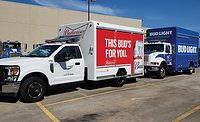Distribution
Should you buy or lease your beverage trucks?
Leasing more attractive in financial uncertainty

It’s an evergreen question in fleet management: do you buy or lease equipment? It’s one that comes up even more often when the economy contracts, as distributors re-assess their resources. It also is unclear how long the current pandemic-driven downturn will last and whether it will have a sizeable influence on the lease-versus-buy decision.
“Downturns have an impact, though not for us directly,” says Gary Thompson, executive vice president and general manager at Powers Distributing, Orion, Mich. “[In] downturns, interest rates drop, cash is in shorter supply, so leasing may become more attractive. Depreciation, tax and stimulus policy are big — they determine who gets what write-offs and when. With 100 percent immediate write-off, if you have the cash to purchase or the ability to leverage purchases, buying becomes more interesting.”
But in both boom times and in bust, the real X-factor is maintenance. It’s less of an issue for distributors like Powers that have their own in-house maintenance shop. But those distributors who don’t have that service are more likely to benefit from a full-service lease program.
“When the truck breaks down, on the leasing side it’s painful for both parties,” says Chuck Davis, director of sales for PACCAR Leasing Co., Bellevue, Wa. “So we both have a vested interest to make it work well.”
Maintenance plan defrays costs
When fleet managers opt for a full-service lease, they’re typically paying for a maintenance schedule for the duration of the lease. “In ownership, when the truck goes to the shop [the shop] is invoicing someone, whether it’s [the lease company] or [the fleet], Davis explains. “They’re billing time at the market rate.”
If the fleet is paying, say, $450 a month to the lease company for a maintenance plan, service expenses become considerably more predictable, Davis notes. “Companies, all the time, will spend $4,000 to have a set of tires put on and that’s one month’s budget that may or may not have been planned,” he says. “[With a full-service lease] we may have to put on a set of tires for $4,000, but the customer is only paying their standard $450 a month maintenance.”
When approaching a lease agreement, Davis advises that fleet managers consider the time and mileage expectations for the equipment — and not just for the trucks themselves but for all of their components.
“You need to make sure that all of the components are built to last for that period — and not just last, last reliably,” Davis warns. “That’s what our market is built upon: reliability and predictability. What can really ruin a lease agreement is that, say, in the last year [of the term], things start to fail or [the equipment] doesn’t hold up because it was not spec’d correctly. So, real diligence around the specifications of the equipment is really important.”
Powers’s fleet is a mix of owned and leased equipment. Depending on the terms, it has leased some of its tractors. For its trailers, the distributor has opted for purchasing them as they tend to last at least 20 years and Powers is able to refurbish them every four years.
In the end, it all comes down to a distributor’s individual needs, access to maintenance and cash in hand.
“Recognize that outsourcing can certainly be a real advantage, removing some of the complexity out of the distribution system,” Davis says.
Looking for a reprint of this article?
From high-res PDFs to custom plaques, order your copy today!







